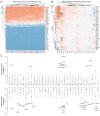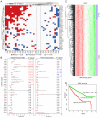The BRCAness Landscape of Cancer
- PMID: 36497135
- PMCID: PMC9738094
- DOI: 10.3390/cells11233877
The BRCAness Landscape of Cancer
Abstract
BRCAness refers to the damaged homologous recombination (HR) function due to the defects in HR-involved non-BRCA1/2 genes. BRCAness is the important marker for the use of synthetic lethal-based PARP inhibitor therapy in breast and ovarian cancer treatment. The success provides an opportunity of applying PARP inhibitor therapy to treat other cancer types with BRCAness features. However, systematic knowledge is lack for BRCAness in different cancer types beyond breast and ovarian cancer. We performed a comprehensive characterization for 40 BRCAness-related genes in 33 cancer types with over 10,000 cancer cases, including pathogenic variation, homozygotic deletion, promoter hypermethylation, gene expression, and clinical correlation of BRCAness in each cancer type. Using BRCA1/BRCA2 mutated breast and ovarian cancer as the control, we observed that BRCAness is widely present in multiple cancer types. Based on the sum of the BRCAneass features in each cancer type, we identified the following 21 cancer types as the potential targets for PARPi therapy: adrenocortical carcinoma, bladder urothelial carcinoma, brain lower grade glioma, colon adenocarcinoma, esophageal carcinoma, head and neck squamous carcinoma, kidney chromophobe, kidney renal clear cell carcinoma, kidney renal papillary cell carcinoma, liver hepatocellular carcinoma, lung adenocarcinoma, lung squamous cell carcinoma, mesothelioma, rectum adenocarcinoma, pancreatic adenocarcinoma, prostate adenocarcinoma, sarcoma, skin cutaneous melanoma, stomach adenocarcinoma, uterine carcinosarcoma, and uterine corpus endometrial carcinoma.
Keywords: BRCA1/2; BRCAness; PARP inhibitors; genetic defects; synthetic lethal.
Conflict of interest statement
The authors declare no conflict of interest.
Figures






Similar articles
-
APOBEC3C is a novel target for the immune treatment of lower-grade gliomas.Neurol Res. 2024 Mar;46(3):227-242. doi: 10.1080/01616412.2023.2287340. Epub 2024 Jan 22. Neurol Res. 2024. PMID: 38007705
-
Systematic pan-cancer analyses of the potential function of the Golgi scaffold protein PAQR3.Sci Rep. 2024 Feb 6;14(1):3030. doi: 10.1038/s41598-024-53489-z. Sci Rep. 2024. PMID: 38321173 Free PMC article.
-
Integrative omics analysis reveals relationships of genes with synthetic lethal interactions through a pan-cancer analysis.Comput Struct Biotechnol J. 2020 Oct 21;18:3243-3254. doi: 10.1016/j.csbj.2020.10.015. eCollection 2020. Comput Struct Biotechnol J. 2020. PMID: 33240468 Free PMC article.
-
The emerging role of homologous recombination repair and PARP inhibitors in genitourinary malignancies.Cancer. 2017 Jun 1;123(11):1912-1924. doi: 10.1002/cncr.30631. Epub 2017 Mar 21. Cancer. 2017. PMID: 28323334 Free PMC article. Review.
-
The status of poly(adenosine diphosphate-ribose) polymerase (PARP) inhibitors in ovarian cancer, part 2: extending the scope beyond olaparib and BRCA1/2 mutations.Clin Adv Hematol Oncol. 2016 Sep;14(9):704-11. Clin Adv Hematol Oncol. 2016. PMID: 27673289 Review.
Cited by
-
Evolutionary Origin of Human PALB2 Germline Pathogenic Variants.Int J Mol Sci. 2023 Jul 12;24(14):11343. doi: 10.3390/ijms241411343. Int J Mol Sci. 2023. PMID: 37511102 Free PMC article.
-
Unique Biological Characteristics of Patients with High Gleason Score and Localized/Locally Advanced Prostate Cancer Using an In Silico Translational Approach.Curr Oncol. 2025 Jul 18;32(7):409. doi: 10.3390/curroncol32070409. Curr Oncol. 2025. PMID: 40710219 Free PMC article.
-
BRCA1 & BRCA2 methylation as a prognostic and predictive biomarker in cancer: Implementation in liquid biopsy in the era of precision medicine.Clin Epigenetics. 2024 Dec 6;16(1):178. doi: 10.1186/s13148-024-01787-8. Clin Epigenetics. 2024. PMID: 39643918 Free PMC article. Review.
-
Clinical response of pancreatic cancer bearing a germline BRCA2 p.I3169M fs*48 variant for platinum-based drug and PARP inhibitor.Jpn J Clin Oncol. 2024 Feb 7;54(2):201-205. doi: 10.1093/jjco/hyad157. Jpn J Clin Oncol. 2024. PMID: 37956396 Free PMC article.
-
Genomic Features of Homologous Recombination Deficiency in Breast Cancer: Impact on Testing and Immunotherapy.Genes (Basel). 2024 Jan 26;15(2):162. doi: 10.3390/genes15020162. Genes (Basel). 2024. PMID: 38397152 Free PMC article. Review.
References
-
- Tutt A., Bertwistle D., Valentine J., Gabriel A., Swift S., Ross G., Griffin C., Thacker J., Ashworth A. Mutation in Brca2 stimulates error-prone homology-directed repair of DNA double-strand breaks occurring between repeated sequences. EMBO J. 2001;20:4704–4716. doi: 10.1093/emboj/20.17.4704. - DOI - PMC - PubMed
MeSH terms
Substances
Grants and funding
LinkOut - more resources
Full Text Sources
Medical
Miscellaneous

